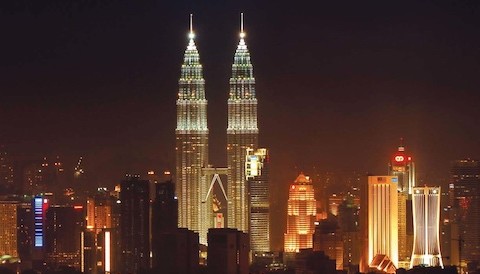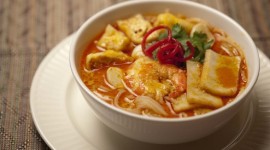
SNAPSHOT
| Population |
1.4 million |
| Cuisine | Peranakan, combining influences from indigenous Malay, Chinese, Indian, Thai and Indonesian communities |
| Signature dishes | Coconut rice (nasi lemak), coconut milk soup noodle (laksa), spicy coconut beef (beef rendang), puffed Indian bread (roti canai), prawns with sambal |
| Wine culture | Developing wine market with a government that discourages alcohol consumption |
| Wine duty | Approximately US$4 per bottle plus 20% additional taxes |

MALAYSIAN CUISINE
Malay cuisine is influenced predominantly by the spices and flavours from the islands of Java and Sumatra in Indonesia. The difference is the addition of Thai and Chinese elements which sets it apart from traditional Indonesian cuisine. Malay blending of spices can include a variety of fresh and dried spices such as ginger, chilli, lemongrass, turmeric, saffron and cumin with flavourful bases such as belacan (shrimp paste).
Malay food meets Chinese ingredients and cooking methods in Peranakan cuisine, also called Nonya cuisine. The early Chinese labourers who settled in Malaysia, Singapore and parts of Indonesia married local Malay women. They adopted Chinese cooking techniques and ingredients such as the use of the wok with high heat and the love for noodles, then added Malay, Indian and Indonesian spices and sauces. Many dishes evolved to such an extent that a unique cuisine was created combining fragrant spices with spicy and sour flavours.
Major ingredients in Peranakan cooking include coconut milk, galangal, pandan and kaffir leaves, lemongrass, tamarind and belacan. Key cities like Malacca that sprouted Nonya cuisine are along the coastal regions of the Malay peninsula. Thus, seafood features highly such as fresh fish, shellfish as well as preserved shrimp. These combinations produce intensely spicy and sour, fragrant, tangy and herbal dishes filled with flavour. One distinctive aspect of Nonya cuisine is the use of belacan and other salty preserved shrimps like cincaluk. The salty, pungent taste often balances the sour and spicy flavours in a dish. Typical condiments to a Nonya meal combine the salty cincaluk with lime juice, shallots and chillies to accompany fried seafood and other side dishes.
The Chinese influence is very strong in Kuala Lumpur and Chinatown, also known as Petaling Street, is filled with various regional Chinese restaurants serving a broad array of meals from high-end Cantonese fare to comfort food like Hainanese chicken rice and Hokkien noodles. One of the most popular Chinese imports is noodles and it has become a staple of KL-ites from the hawkers’ stalls serving fried bee hoon to upmarket restaurants combining expensive seafood with fried noodles. Among the Chinese cuisines, Cantonese food is the most well represented in fine dining restaurants at the five-star hotels around town. Other regional cuisines such as Sichuan and Shanghainese find favour in less opulent settings throughout the city.
FOOD AND DINING CULTURE
Along the streets of Kuala Lumpur, the smell of food is everywhere – the fragrant aroma of Indian curry, the piquant and pungent smell of Peranakan sauces or the oil and soy sauce from Chinese stir fries. The hot and humid climate allows the aromas from hawkers’ stalls and mobile carts selling food to linger in the air. These are still around, though increasingly, they are being marginalised. Beneath the tall, modern office towers, the city enjoys a vibrant and colourful street food culture. The fact that Singaporeans travel to Kuala Lumpur just to eat is testimony to the quality of its street food
What makes hawkers’ food unique in Kuala Lumpur is the variety and range of food available which reflects the multi-cultural mix of its city dwellers. Peranakan influences outlets that offer piquant-flavoured laksa and spicy otak-otak. The Malay influence inspires specialists in nasi lemak while the Chinese influence has created a strong following for all types of noodles, from Hokkien mee to char kway teow (fried flat rice noodles). The Indian influence is also strong despite the fact that Indians only make up a small portion of the population. Banana leaf restaurants and cafés abound and stalls offering roti canai with various dahl (flat puffed bread with legume dips) and chicken masala (fragrant spicy chicken) are extremely popular. The specialties of most outlets and restaurants are obvious in their names, e.g. Soong Kee Beef Noodles, Ka-Soh Fishhead Seafood restaurant and Nasi Kandar (rice meal) Pelita.
Stand-alone restaurants have mushroomed throughout the city since the early 1990s. Key differences among the diverse religions represented in the city mean that eateries that cater to Muslims have no pork on the menu while those that cater to Hindus have no beef or are vegetarian. Southeast Asian restaurants are a growing segment – e.g. Bijan is well regarded for its modern take on local food while Tamarind Springs and Cochine are popular for Indochinese cuisine. Although every type of food from Middle Eastern to Spanish to Japanese is widely available, what Kuala Lumpur restaurants do well is the fusion of various cuisines.









